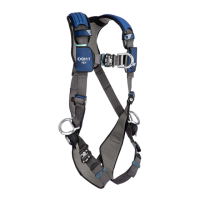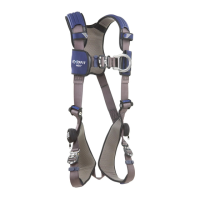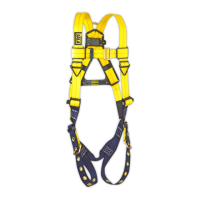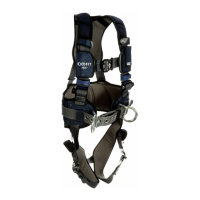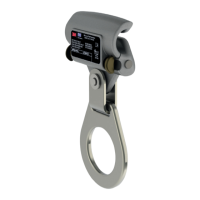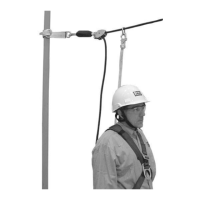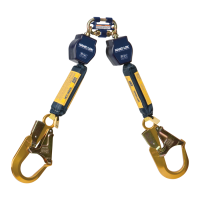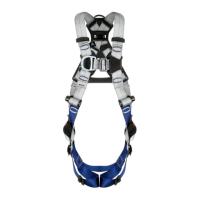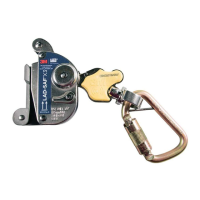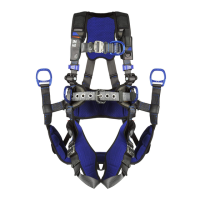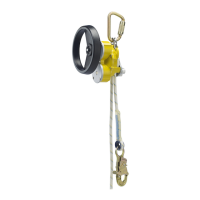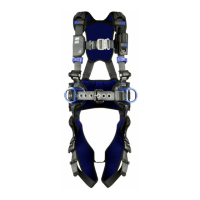12
• Hazards: Use of this equipment in areas where surrounding hazards exist may require additional precautions to reduce the
possibility of injury to the user or damage to the equipment. Hazards may include, but are not limited to: high heat, caustic
chemicals, corrosive environments, high voltage power lines, explosive or toxic gases, moving machinery, or overhead materials
that may fall and contact the user or fall arrest system. Avoid working where your Lanyard may cross or tangle with that of
another worker. Avoid working where an object may fall and strike the Lanyard; resulting in loss of balance or damage to the
Lanyard. Do not allow the Lanyard to pass under arms or between legs.
• Sharp Edges: Sharp edges the Lanyard lifeline can contact during a fall must have a minimum radius of 0.125 in (0.3
cm).
Where contact with a sharp edge is unavoidable, cover the edge with a protective material.
2.0 Use
2.1 FALL PROTECTION AND RESCUE PLAN: The employer must have a Fall Protection and Rescue Plan in place. The
plan should provide guidelines and requirements for an employer’s managed fall protection program, including policies,
duties and training; fall protection procedures; eliminating and controlling fall hazards; rescue procedures; incident
investigations; and evaluating program effectiveness.
2.2 INSPECTION FREQUENCY:
Lanyards shall be inspected by the worker
1
before each use. Additionally, inspections shall be
conducted by a competent person
2
other than the user. Extreme working conditions (harsh environment, prolonged use,
etc.) may necessitate more frequent competent person inspections. The competent person shall determine appropriate
inspection intervals.
Inspection procedures are described in the Inspection & Maintenance Log (Table 2). Results of
the Competent Person inspection should be recorded in the Inspection and Maintenance Log or recorded with the Radio
Frequency Identification (RFID) system.
2.3 BODY SUPPORT: A Full Body Harness must be used with the Energy Absorbing Lanyard. The harness connection point must be
above the user’s center of gravity. A body belt is not authorized for use with the Energy Absorbing Lanyard. If a fall occurs when
using a body belt, it may cause unintentional release or physical trauma from improper body support.
2.4 COMPATIBILITY OF COMPONENTS: Unless otherwise noted, 3M equipment is designed for use with 3M approved
components and subsystems only. Substitutions or replacements made with non approved components or subsystems may
jeopardize compatibility of equipment and may affect safety and reliability of the complete system.
2.5 COMPATIBILITY OF CONNECTORS: Connectors are considered to be compatible with connecting elements when they
have been designed to work together in such a way that their sizes and shapes do not cause their gate mechanisms to
inadvertently open regardless of how they become oriented. Contact 3M if you have any questions about compatibility.
Connectors (hooks, carabiners, and D-rings) must be capable of supporting at least 5,000 lbs. (22.2 kN). Connectors
must be compatible with the anchorage or other system components. Do not use equipment that is not compatible.
Non-compatible connectors may unintentionally disengage (see Figure 6). Connectors must be compatible in size, shape,
and strength. Self-locking snap hooks and carabiners are required. If the connecting element to which a snap hook or
carabiner attaches is undersized or irregular in shape, a situation could occur where the connecting element applies a
force to the gate of the snap hook or carabiner (A). This force may cause the gate to open (B), allowing the snap hook or
carabiner to disengage from the connecting point (C).
2.6 MAKING CONNECTIONS: Snap hooks and carabiners used with this equipment must be self-locking. Ensure all
connections are compatible in size, shape and strength. Do not use equipment that is not compatible. Ensure all
connectors are fully closed and locked. 3M connectors (snap hooks and carabiners) are designed to be used only as
specied in each product’s user’s instructions. See Figure 7 for examples of inappropriate connections. Do not connect
snap hooks and carabiners:
A. To a D-ring to which another connector is attached.
B. In a manner that would result in a load on the gate. Large throat snap hooks should not be connected to standard
size D-rings or similar objects which will result in a load on the gate if the hook or D-ring twists or rotates, unless the
snap hook is equipped with a 3,600 lb (16 kN) gate.
C. In a false engagement, where size or shape of the mating connectors are not compatible and, without visual
conrmation, the connectors seem fully engaged.
D. To each other.
E. Directly to webbing or rope lanyard or tie-back (unless the manufacturer’s instructions for both the lanyard and
connector specically allows such a connection).
F. To any object which is shaped or dimensioned such that the snap hook or carabiner will not close and lock, or that
roll-out could occur.
G. In a manner that does not allow the connector to align properly while under load.
1 Worker: Any person wo is protected from falling by an active fall protection system; or, in the case of a fall arrest System; an person who might fall while attached to
the system.
2 Competent Person: An individual designated by the employer to be responsible for the immediate supervision, implementation, and monitoring of the employer’s
managed fall protection program who, through training and knowledge, is capable of identifying, evaluating, and addressing existing and potential fall hazards, and
who has the employer’s authority to take prompt corrective action with regard to such hazards.
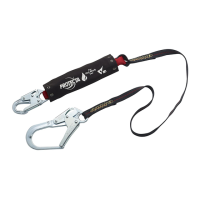
